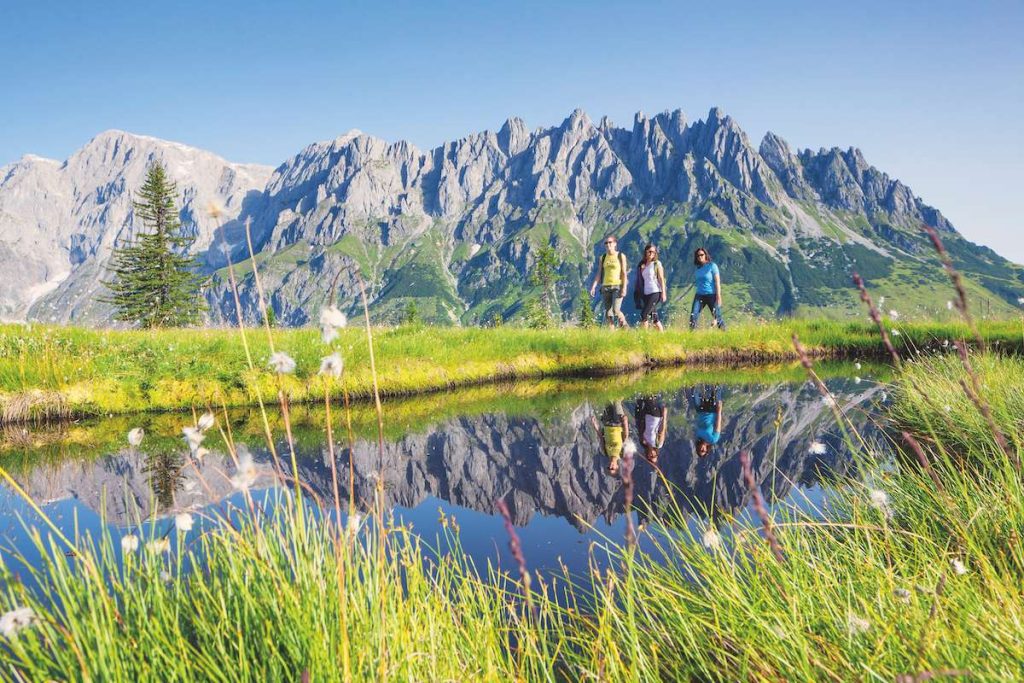The main reasons for hiking are experiencing nature, fresh air, the beauty of nature and landscape, fauna and flora. Another aspect that is becoming increasingly important is health as a motive for hiking holidays, with the scientific evidence of the positive effects of hiking on health and well-being now constantly growing.
One of the first approaches to investigating the health effects of Alpine mountain hiking was represented by the “Austrian Moderate Altitude Studies” (AMAS) conducted in Austria. AMAS I (2000) focused on the indication of the metabolic syndrome, a combination of overweight, disturbed blood sugar and blood fat metabolism, as well as high blood pressure, whereas AMAS II (2006) focused on persons with high stress levels. The studies proved that an active sojourn (a combination of hiking and active/passive regeneration) at moderate Alpine altitudes (1,500 – 2,500 metres a.s.l.) under the guidance of professional coaches has positive effects in persons with metabolic syndrome as well as in clients suffering from stress.
Mountain hiking and healthy aging:
Healthy aging and physical activity go hand in hand: the longest possible healthy life is therefore directly dependent on an active lifestyle, while efficient interventions are needed to preserve functional abilities so as to prolong disability-free life expectancy.
Mountain hiking is a very popular pastime among older people. More than 6 million people over 60 years of age undertake mountain activities in the Alps every year, but mountaineering demands a relatively high level of physical fitness. Aging is typically associated with declining fitness, but this decline is not solely the result of aging; it is mostly the price to be paid for physical inactivity.
When mountain hiking, people are often confronted with rapidly changing environmental conditions such as path gradients, stony or narrower passages, altitude, weather conditions, or ascending and descending sections. These constantly changing conditions require continual proprioceptive feedback, thus promoting the diversification of gait patterns and balance responses.
Mountain hiking could therefore be an effective form of training for older people, addressing aerobic capacity, strength and balance.

Health tourism potential:
- Development of offers in combination with other natural resources (e.g. balneotherapy, waterfalls, etc.).
- Development of target-group specific products (e.g. hiking trails with different characteristics for specific indications such as cardiorespiratory fitness, chronic back pain, etc.) with reference to increasing levels of lifestyle diseases.
Studies of medical evidence:
- Resource: mountain hiking at medium (1,700 m) and low (200 m) altitudes. Indication: metabolic syndrome (Neumayr et al., 2014): evidence level Ib
- Resource: mountain hiking and balneotherapy. Indication: osteoporosis prevention (Winklmayr et al., 2015): evidence level Ib
- Indication: stress (Niedermeier, Grafetstätter, Hartl & Kopp, 2017): evidence level Ib
- Indication: mood – emotional reactions (Niedermeier, Einwanger, Hartl & Kopp, 2017): evidence level Ib
- Resource: mountain hiking + waterfall. Indication: medium to high stress levels; burnout prevention (Grafetstätter et al., 2017): evidence level Ib
- Resource: mountain hiking + iodine-sulphur-Na-Cl-water / brine baths / Na-Ca-Cl-SO4-water. Indication: prevention of falls; healthy aging: stamina and strength (Prossegger et al., 2019): evidence level Ib
- Resource: mountain hiking + Mg-Ca-SO4 thermal water. Indication: non-specific chronic pain in the lower back area (Huber et al., 2019): evidence level Ib
Download a PDF:
Enter your E-Mail address, and get a pdf to review later.